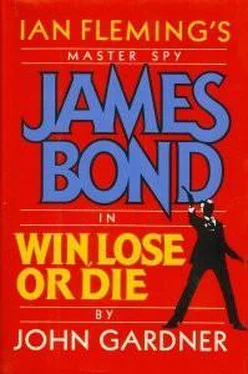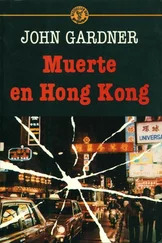Win, Lose or die by John Gardner
WIN in the Gulf
An hour before dawn, in the Straits of Hormuz: a dark and dangerous time and place. The air was a chill mixture of sea and sweetness, giving no hint of the heat that would be generated once day took over. The massive Japanese-registered oil-tanker Son of Takashani slowly ploughed its way towards the Gulf of Oman and comparative safety. Its vast deck rolled gently; the tall superstructure, rising from the stern, looking like a block of flats, appeared to tip more violently than the deck because of its height.
Every officer and rating aboard could feel a tightening of the stomach muscles, the sense of urgency, and the absurd detached feeling which people experience when they know any minute could bring death by fire, explosion, bullet or water. Many had died of these along this stretch of water over the years of the Gulf war.
Both the Americans and British had helped by minesweeping, and escorting the oil-tankers. But, on this occasion, the Son of Takashoni had been forced to make the trip without the assistance of either the Amen can Fleet or the Royal Navy, The Japanese did, however, take precautions.
Armed men were on the bridge, at vantage points in the superstructure, and even on the deck. Some were always there during the journey from the Iraqi oil-fields through the Gulf, but, at the hours of dawn and dusk, extra hands with weapons kept a look-out.
These were the hours of high risk.
On the bridge the men carried small, lethal Beretta 12S - the model S versions, with metal stocks and a cyclic rate of 00-plus rounds per minute. The heavier General Purpose Machine-Guns were set on swivel mountings: two to port, and another pair to starboard on the deck; while four more were set in the superstructure, giving a wide field of fire, both fore and aft. These were all .50 calibre Browning M2 HBs, unequalled in their class for both range and firepower, their ammunition belts sprinkled with tracer rounds.
The Son of Takashani’s Master, Kiyoshi Akashi, never missed being on the bridge at this time of day. He rather enjoyed the sense of tension and danger.
The radar on the bridge searched the sea for other shipping, and the air for any hostile planes. They could do little against mines, but at least they stood a chance if the so-called Iranian Revolutionaries made one of their hit and run attacks in small motorised craft.
Reaching upwards, this same radar could pinpoint aircraft up to ten miles away at around 10,000 feet. Above that height the invisible beams could not reach, but aircraft attacks in the Gulf usually came in low. It was unfortunate that, on this particular dawn, the attack would come from the unexpected height of around 25,000 feet.
Unknown to the officers and men of the Son of Takashani, a giant C-130 Hercules transport aircraft was flying through the dawn sky some fifty miles East of them. The Hercules was painted an overall matt black, and bore no markings: neither serial numbers nor insignia. On the flight deck the navigator gave a terse instruction to the pilot.
The seven turbo-prop engines were throttled back, and the 136,000 pounds of aeroplane began to descend from 30,000 to 25,000 feet.
The navigator put a hand to his earphones, straining to hear the constant voice which came in on their frequency, giving vital information on wind strength and direction through the various heights right down to sea level. These reports came via an ocean-going yacht equipped with the most sophisticated meteorological equipment and radio as the vessel cruised off Khaimah, on the coast of the United Arab Emirates. The data was rapidly fed into the navigator’s computer.
Seconds later he was able to tell the pilot the exact points at which they should release their load. “Exactly 25,000 feet. First stick fifteen miles behind target; second stick two points to starboard, third stick four points port.”
The pilot acknowledged, levelled out at 25,000 feet and repeated the instructions to the jumpmaster, who, like the twenty other men in the cargo bay, wore a woollen helmet, goggles and an oxygen mask. A throat mike carried his query to the pilot “How long, skipper?”
“Five minutes. Opening cargo doors now.” There was a whine of hydraulics as the doors slid back and the loading bay went down like a drawbridge. At 25,000 feet dawn had already broken, the pink pearly light visible behind them. Below there was still darkness, while at the Hercules’ altitude it was freezing cold in the thin air. Every man in the cargo bay had any bare flesh covered against frostbite.
The jumpmaster gave a signal, and the twenty men who sat, facing inwards on the hard metal benches stood up, responding to hand signals.
They were dressed in black: black jump suits, boots, gloves, helmets and the oxygen masks and goggles, together with an assortment of weaponry, including AK47 Kalashnikovs, Galil automatic assault rifles, and Skorpion sub-machine-guns; grenades and, in two cases, clumsy grenade launchers, all firmly clamped onto black webbing covering their chests.
Above them, running the length of the cargo bay, what looked like huge black bats hung from oiled tracks which ended twenty feet short of the cargo ramp. The men now formed a line under these sinister shapes, which were large hang-gliders, unpowered and with near-rigid wings made of strengthened canvas, impregnated with a high-powered, long-lasting solution of de-icing fluid.
From each set of wings hung a light alloy framework onto which each man now strapped himself, using a harness specially designed with a quick release lock, similar to those used on parachutes. The harnesses had been adjusted before take-off, and allowed for interchangeable hanging and sitting positions on the light frameworks.
These men had rehearsed and practised with the craft over deserts and lonely tracts of land in all kinds and conditions of weather. They were a hand-picked and well-trained band who could, after their six months of hard testing, launch themselves from heights of 25,000 feet and spiral down to land within a carefully marked and prescribed area.
The cargo bay was filled with noise, the clamour of the engines and the rush of air filtering back through the open doors.
Instructions were reduced to hand signals and the jumpmaster banged his right palm flat on his chest, then lifted both hands, spreading the fingers wide - ten; then another ten; followed by five.
The men, standing in the framework of their hang-gliders, bent their heads to the small altimeters attached to their right wrists, setting them to 25,000 feet. In a minute or so their lives would depend on the accurate settings above sea level. Most of them also glanced at the small compasses attached to their left wrists.
These two simple instruments were the only devices which would assist them in the long glide down to the sea, and in what they had dubbed Operation WIN.
“Prepare for stick one.” The pilot’s voice filled the jumpmaster’s ears, and he signalled for the first group of ten men to stand by. They walked steadily towards the open doors at the rear of the aircraft, their gliders moving above them smoothly on the twin tracks of rail.
“All sticks stand by,” the pilot said. Again the jumpmaster signalled and the further two groups of five men took up their places.
“Stand by stick one. Stick one go.
The jumpmaster’s hand came down and the first ten men launched themselves, at ten-second intervals, into space.
The Hercules banked sharply to the left.
“Stand by stick two. Stick two go.
Another signal and five men glided down towards the film of darkness below as the Hercules banked right. Stick three went out smack on time, at the jump master’s signal. The cargo doors closed as the aircraft turned and climbed steeply, heading back to its secret home.
Читать дальше











